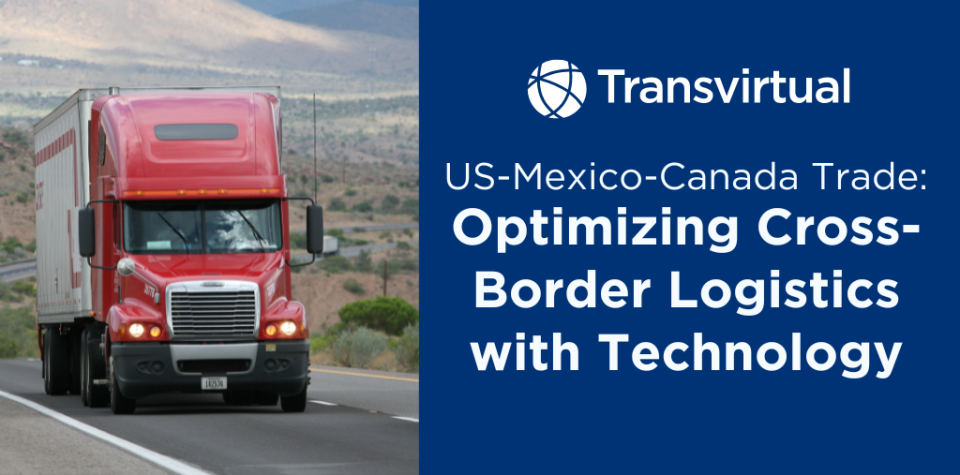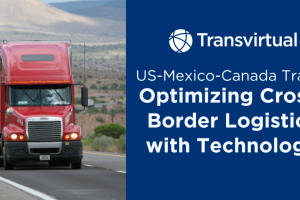Table of Contents
Trade between the United States, Mexico, and Canada, totaling $1.8 trillion annually, directly impacts a vast range of industries and businesses worldwide. From automotive manufacturing to agriculture, industries rely on cross-border logistics to keep supply chains moving.
However, this interconnected trade not only boosts business opportunities but also creates challenges in logistics. They need to manage complex customs, shipping delays, and border regulations.
Leveraging the right technological solutions simplifies border-crossing procedures, mitigates risks, and ensures a smoother flow of goods.
Explore below the key considerations, challenges, and strategies for navigating US-Mexico-Canada trade and how technology can transform cross-border logistics into your strategic advantage.
The Importance of Cross-Border Trade in North America
The US-Mexico-Canada trade corridor is not only a cornerstone of regional commerce but also a global powerhouse. Underpinned by the United States-Mexico-Canada Agreement (USMCA), this interconnected market facilitates the movement of billions of dollars worth of goods daily.
Key industries such as automotive, technology, agriculture, and energy rely on efficient cross-border logistics to meet consumer demand and drive economic growth. However, the scale and diversity of goods traded also highlight the complexities inherent in managing cross-border supply chains, from adhering to strict regulatory requirements to ensuring seamless transportation across vast distances.
Cross-border trade helps businesses expand into neighboring markets, unlocking access to new customers and suppliers that can significantly fuel growth. However, smaller companies often face challenges, such as limited resources, to navigate complex customs regulations and high transportation costs that can strain their budgets.
Despite these obstacles, the right combination of technology and strategic planning can help these businesses overcome barriers and capitalize on the vast opportunities of the thriving North American trade ecosystem.
Key Considerations in Cross-Border Transportation
Cross-border logistics require careful planning to account for differing regulations, infrastructure limitations, and labor availability across the US, Mexico, and Canada. While the USMCA provides some harmonization of trade rules, businesses still need to address country-specific customs procedures, tariffs, and local regulations.
Key considerations include:
Regulatory Alignment: Each country has its own customs and trade regulations. Ensuring compliance requires understanding tariffs, free trade agreements like USMCA, and industry-specific requirements.
Shipment Visibility: Real-time tracking provides critical insights into where shipments are, ensuring proactive responses to delays.
Cost Efficiency: Selecting the right transportation mode and optimizing routing significantly reduces costs while maintaining delivery timelines.
Customs Documentation and Compliance: Properly completing and submitting customs documents is essential for avoiding delays. Even small errors can trigger inspections or fines. Automated systems can help ensure the accuracy and timely submission of required paperwork.
Border Crossing Delays and Congestion: Border crossings experience significant delays, especially at busy ports of entry. Planning for additional time, having contingency routes, and utilizing expedited customs programs can help mitigate this risk and keep shipments on schedule.
Modal Choices: Truck, Rail, or Air
Choosing the right transportation mode is pivotal to efficient cross-border logistics. The decision impacts delivery times, costs, and overall supply chain efficiency.
Trucking: Trucking, which carries approximately 72.5% of the freight in the United States alone, is by far the most widely used transportation option. However, it faces challenges like driver shortages, border congestion, and varying regulations at each crossing.
Rail: Ideal for large shipments and cost-sensitive freight, rail is a reliable alternative for intermodal transportation. It’s particularly useful for bulk commodities but may have longer lead times due to limited rail infrastructure and capacity.
Air: Best for high-value or time-sensitive goods, air freight is the fastest but most expensive option. It’s especially valuable for industries requiring quick turnaround, like electronics and pharmaceuticals, though it is usually not cost-effective for larger shipments.
Businesses often use a combination of these modes, relying on advanced TMS solutions to coordinate and optimize multi-modal shipments. By evaluating factors like shipment size, urgency, and cost, businesses can design tailored logistics strategies that balance speed, efficiency, and cost.
Navigating Border-Crossing Procedures
Crossing borders between the US, Mexico, and Canada requires navigating various procedures that differ depending on the mode of transport, the type of goods, and the specific border crossing. These processes are subject to strict regulations. Companies must stay abreast of any changes to these regulations, which can vary over time, to avoid unnecessary delays or penalties.
Trucks, in particular, often face delays ranging from a few hours to more than 10 hours. To reduce these bottlenecks you should focus on:
Pre-Clearance Programs: Leverage programs like FAST (Free and Secure Trade) to expedite customs clearance for trusted shippers by up to 25-40%.
Digital Documentation: Ensure all required paperwork, such as commercial invoices, bills of lading, and certificates of origin, is accurate and digitized for faster processing.
Regulatory Knowledge: Stay updated on border policies, as they can shift due to geopolitical or economic changes.
Technology solutions simplify these processes, offering automated compliance checks and instant alerts for missing or incorrect documentation.
Risk Management and Common Challenges
Navigating the complexities of cross-border logistics between the US, Mexico, and Canada requires careful risk management to address the inherent challenges of this trading environment. These risks include everything from fluctuating tariffs and customs delays to supply chain disruptions due to political or economic shifts. Effective risk management strategies are crucial to maintaining smooth operations and avoiding costly delays.
One key element of risk management is ensuring compliance with ever-changing regulations. Failure to comply with customs rules, trade agreements like the USMCA, or industry-specific standards can result in penalties, fines, or shipment rejection. In addition, security threats, including theft or damage during transit, further add to the complexities of managing cross-border logistics.
Tariffs and Regulatory Compliance: Businesses must stay informed on trade policies and tariffs, which can impact the cost-effectiveness of shipments. Compliance with regulations like the USMCA, which has streamlined some processes, is vital to avoiding slowdowns at the border.
Supply Chain Disruptions: Political instability, natural disasters, or other disruptions can interfere with cross-border logistics, causing delays and forcing businesses to find alternative solutions.
Cybersecurity Risks: With the increasing reliance on digital tools and online platforms in cross-border logistics, businesses must safeguard against cyber threats. Ensuring secure transmission of sensitive data, such as customs documents and shipment details, is critical to protecting against breaches and maintaining smooth operations.
Proactive Risk Management and Technology Solutions for Cross-Border Logistics
Effective risk management in cross-border logistics is critical for preventing delays and safeguarding profitability. With complex international regulations, fluctuating tariffs, and the unpredictable nature of global supply chains, businesses must be prepared for a variety of contingencies.
Proactive strategies not only minimize disruptions but also ensure smooth, cost-effective operations across the US-Mexico-Canada trade lanes, helping businesses maintain their competitive edge in an ever-evolving market.
Key risk management practices include:
Real-Time Monitoring: GPS-enabled tracking systems provide full visibility into shipments, reducing the risk of theft and misplacement, and ensuring that shipments stay on schedule.
Contingency Planning: Incorporating buffer times and alternative routes into logistics plans helps maintain flexibility in the face of unexpected disruptions.
Compliance Assurance: Cloud-based systems offering real-time regulatory updates help businesses stay compliant with evolving trade policies, reducing the risk of penalties or delays at the border.
Technology likewise plays a vital role in enhancing compliance and operational efficiency. Cloud-based transportation management systems offer a range of tools designed to streamline processes and improve supply chain performance:
Automated Documentation: These systems auto-generate and validate the required customs paperwork, simplifying the clearance process and ensuring shipments comply with local regulations.
Regulatory Updates: Real-time tools provide instant updates on changes in trade policies and regulations, helping businesses stay compliant with minimal effort.
Real-Time Visibility: GPS tracking and live data feeds allow companies to track shipments across borders, increasing transparency and mitigating risks.
Data-Driven Optimization: Analytics tools optimize routes, reduce costs, and help identify inefficiencies, enabling businesses to adapt to changes or challenges quickly.
By integrating proactive risk management practices with these advanced technology solutions, companies can reduce human error, enhance efficiency, and stay agile in the fast-paced world of cross-border logistics.
Best Practices for Smooth Cross-Border Operations
To ensure a seamless cross-border logistics experience, here’s what you should focus on:
Invest in Training: Educate staff on regulatory requirements and technology tools.
Build Strong Partnerships: Collaborate with customs brokers, carriers, and local partners who understand the nuances of cross-border trade.
Leverage Technology: Implement systems that integrate transport and warehouse management functionalities, offering end-to-end visibility and control.
Maintain Flexibility: Plan for contingencies, from alternative routes to backup transportation modes.
Monitor KPIs: Regularly evaluate performance metrics like on-time delivery rates and customs clearance times to identify areas for improvement.
Maximizing the Potential of US-Mexico-Canada Trade with Technology
There’s a wealth of business opportunities for cross-border logistics in the US-Mexico-Canada trade. But you need a proactive technology-driven approach to fully capitalize on them. Embracing advanced technology solutions lets businesses streamline processes, ensure compliance, and enhance operational efficiency.
Real-time tracking, automated documentation, and instant regulatory updates are just a few tools that help companies navigate the complexities of cross-border trade, reducing risks and avoiding costly delays. With the right systems in place, businesses can make smarter decisions, adapt swiftly to changing regulations, and maintain a competitive edge in this dynamic market. Discover how by exploring our logistics software solution now.


